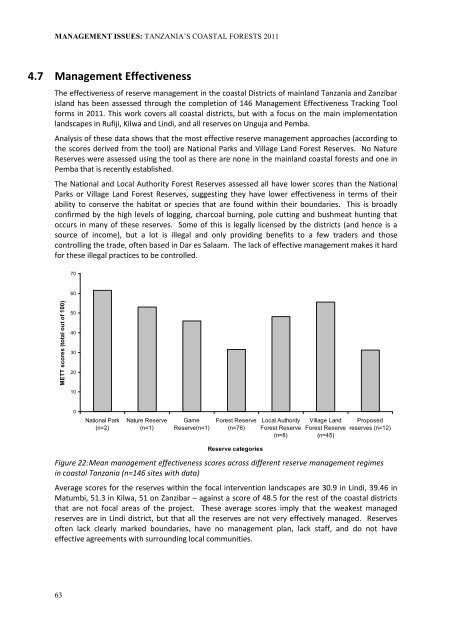Neil D. Burgess, Paul Harrison, Peter Sumbi, James Laizer, Adam ...
Neil D. Burgess, Paul Harrison, Peter Sumbi, James Laizer, Adam ...
Neil D. Burgess, Paul Harrison, Peter Sumbi, James Laizer, Adam ...
Create successful ePaper yourself
Turn your PDF publications into a flip-book with our unique Google optimized e-Paper software.
METT scores (total out of 100)<br />
MANAGEMENT ISSUES: TANZANIA’S COASTAL FORESTS 2011<br />
4.7 Management Effectiveness<br />
The effectiveness of reserve management in the coastal Districts of mainland Tanzania and Zanzibar<br />
island has been assessed through the completion of 146 Management Effectiveness Tracking Tool<br />
forms in 2011. This work covers all coastal districts, but with a focus on the main implementation<br />
landscapes in Rufiji, Kilwa and Lindi, and all reserves on Unguja and Pemba.<br />
Analysis of these data shows that the most effective reserve management approaches (according to<br />
the scores derived from the tool) are National Parks and Village Land Forest Reserves. No Nature<br />
Reserves were assessed using the tool as there are none in the mainland coastal forests and one in<br />
Pemba that is recently established.<br />
The National and Local Authority Forest Reserves assessed all have lower scores than the National<br />
Parks or Village Land Forest Reserves, suggesting they have lower effectiveness in terms of their<br />
ability to conserve the habitat or species that are found within their boundaries. This is broadly<br />
confirmed by the high levels of logging, charcoal burning, pole cutting and bushmeat hunting that<br />
occurs in many of these reserves. Some of this is legally licensed by the districts (and hence is a<br />
source of income), but a lot is illegal and only providing benefits to a few traders and those<br />
controlling the trade, often based in Dar es Salaam. The lack of effective management makes it hard<br />
for these illegal practices to be controlled.<br />
70<br />
60<br />
50<br />
40<br />
30<br />
20<br />
10<br />
0<br />
National Park<br />
(n=2)<br />
Nature Reserve<br />
(n=1)<br />
Game<br />
Reserve(n=1)<br />
Forest Reserve<br />
(n=76)<br />
Local Authority<br />
Forest Reserve<br />
(n=8)<br />
Village Land<br />
Forest Reserve<br />
(n=45)<br />
Proposed<br />
reserves (n=12)<br />
Reserve categories<br />
Figure 22: Mean management effectiveness scores across different reserve management regimes<br />
in coastal Tanzania (n=146 sites with data)<br />
Average scores for the reserves within the focal intervention landscapes are 30.9 in Lindi, 39.46 in<br />
Matumbi, 51.3 in Kilwa, 51 on Zanzibar – against a score of 48.5 for the rest of the coastal districts<br />
that are not focal areas of the project. These average scores imply that the weakest managed<br />
reserves are in Lindi district, but that all the reserves are not very effectively managed. Reserves<br />
often lack clearly marked boundaries, have no management plan, lack staff, and do not have<br />
effective agreements with surrounding local communities.<br />
63

















